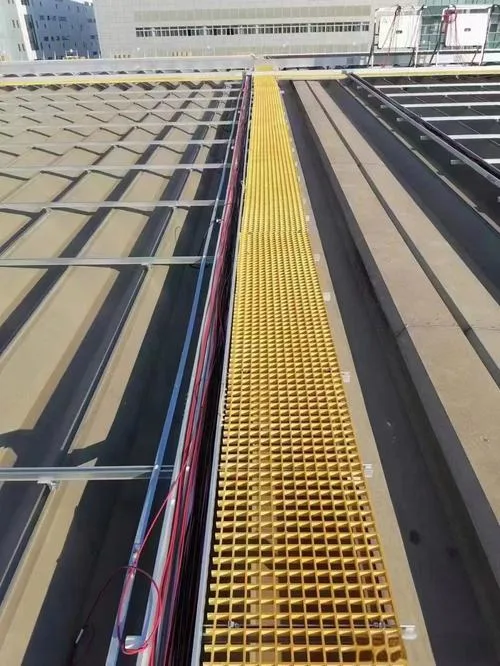Introduction
Choosing the right grating solution can significantly impact the performance, safety, and cost-effectiveness of your project. Two of the most common materials are fiberglass grating panels and steel grating. While steel has long been favored for its strength, fiberglass is growing in popularity due to its corrosion resistance, reduced weight, and overall ease of handling. In this article, we’ll compare fiberglass grating panels to steel grating in terms of benefits, applications, and factors you need to consider to make an informed decision.

fiberglass grating panels
Overview of Fiberglass Grating Panels vs. Steel
Composition and Manufacturing
- Fiberglass Grating Panels: Made from a composite of glass fibers and resin, these panels are produced through a molding or pultrusion process. The result is a lightweight but strong product.
- Steel Grating: Typically manufactured using carbon or stainless steel. In most cases, the individual bearing bars are welded or pressed together to form a rigid grating surface.
By understanding how each is created, you’ll gain insight into their fundamental properties, including their weight, durability, and corrosion resistance.
Weight and Ease of Installation
- Fiberglass Grating Panels: Usually weigh up to 75% less than steel grating, making them easier to carry and install. This can reduce labor costs and minimize the need for heavy machinery.
- Steel Grating: Much heavier, requiring specialized equipment and a more robust support structure. While steel grating is rugged, the added weight can translate into higher installation expenses.
Key Benefits of Fiberglass Grating Panels
Corrosion Resistance
One of the standout features of fiberglass grating panels is their superior corrosion resistance. According to a report by the American Composites Manufacturers Association, composite materials can last significantly longer in harsh environments compared to traditional metals. They are highly resistant to chemicals, saltwater, and extreme temperatures, making them ideal for coastal or chemical plants where corrosion is a primary concern.
Strength and Durability
Despite being much lighter than steel, fiberglass grating panels can withstand heavy loads. Their high glass content allows for excellent tensile and compressive strength. For example, properly designed fiberglass grating often surpasses OSHA’s safety requirements for elevated walkways and platforms.
Safety Features
- Slip Resistance: Fiberglass grating usually features a textured or grit top surface, enhancing traction.
- Non-Conductive Properties: Unlike steel, fiberglass is non-conductive, which adds an extra layer of safety in environments with electrical hazards.
- Flame Retardant Options: Many fiberglass panels are available with flame-retardant resins, increasing safety in areas where fire hazards are present.
Key Benefits of Steel Grating
High Load Capacity
Steel grating is renowned for its load-bearing capabilities. In projects requiring extremely heavy loads or traffic—such as forklift operations or heavy machinery—steel might be the more robust choice. It’s often used in high-traffic industrial applications like bridges and trench covers.
Cost Considerations
While steel grating can be more affordable upfront, total costs may fluctuate depending on factors like ongoing maintenance. Steel also tends to be more readily available, and many suppliers stock standardized sizes. However, the need for regular painting or galvanization to prevent rust may offset the initial savings in the long run.
Comparing Applications
Industrial Environments
- Fiberglass Grating Panels: Best suited for facilities handling corrosive materials, such as chemical plants or water treatment centers. They also work well in areas requiring non-conductivity.
- Steel Grating: Common in heavy-load applications like automotive plants, warehouses, and factories where large equipment must be transported across walkways.
Marine and Chemical Settings
Due to its unmatched corrosion resistance, fiberglass is typically the go-to choice for docks, marinas, and chemical storage areas. Steel may require frequent maintenance, painting, or galvanization in such settings, raising the total cost of ownership.
Commercial and Public Spaces
Both fiberglass grating panels and steel find use in pedestrian walkways, stair treads, and public spaces. Many architects and designers choose fiberglass for its slip resistance, color variety, and non-rusting properties. Steel remains a staple when a classic metallic aesthetic is desired or when extreme load capacities are essential.
Factors to Consider When Choosing
Budget and Lifecycle Costs
- Upfront Costs: Steel grating generally has a lower purchase price than fiberglass, but consider the cost of additional coatings or finishes.
- Long-Term Costs: Fiberglass grating panels can be more economical over time, especially if your application requires extensive corrosion protection.
Maintenance and Long-Term Performance
- Fiberglass Grating Panels: Require minimal maintenance besides regular cleaning. Their inherent corrosion resistance helps them maintain structural integrity for decades.
- Steel Grating: Needs consistent upkeep like repainting or galvanizing to prevent rust and structural damage. Neglecting maintenance can lead to premature replacement.
Regulatory and Environmental Compliance
Fiberglass materials are often chosen for their environmental benefits, as reduced weight and minimal maintenance means less energy and fewer resources spent over a project’s lifecycle. In certain industries or municipalities, local safety and sustainability regulations might favor fiberglass due to its non-conductive and anti-corrosive properties.
Conclusion
Both fiberglass grating panels and steel grating have compelling advantages. Steel is often viewed as the classic choice for high-load applications, while fiberglass stands out in corrosive, electrically sensitive, or low-maintenance environments. Ultimately, the best solution comes down to a balance of performance requirements, budget, and compliance considerations.
CTA
Ready to choose the right grating for your project? We’d love to hear your thoughts and help guide your decision. Leave a comment below with any questions or share this article with your network. And don’t forget to subscribe to our newsletter for more industry insights and practical tips!




























